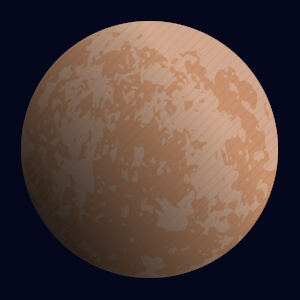


Mercury is the closet planet to the Sun and also the smallest planet in the Solar System. Its surface has many craters, much like the Moon's, and it has almost no atmosphere to retain heat. Mercury is named after the Roman god of the same name, who was the god of shopkeepers, merchants, travelers, and tricksters.
| Mercury | Earth | |
|---|---|---|
| Type of Planet | Terrestrial | Terrestrial |
| Moons | None | The Moon |
| Rings | None | None |
| Mass | 3.301 × 1023 kg | 5.972 × 1024 kg |
| Volume | 60,830,000,000 km3 | 1,083,000,000,000 km3 |
| Closest Distance to Sun | 46,000,000 km | 147,100,000 km |
| Furthest Distance from Sun | 69,820,000 km | 152,100,000 km |
| Average Orbital Speed | 170,500 kph | 107,200 kph |
Although Mercury is the closest planet in our solar system to the sun, its surface temperature can still reach astonishingly frigid lows. In areas illuminated by sunlight—that is, daytime on Mercury— temperatures can reach about 427 °C. While interestingly, this is not quite as hot as Venus' 471 ° C, here's the kicker: because Mercury has no true atmosphere of gases, the temperature in areas not receiving sunlight can plummet to -173 °C. That's a temperature difference of 600 °C!
One day on Mercury, marked by a single complete rotation around its axis, lasts about 176 Earth days. Oddly enough, because Mercury's orbital velocity is so high, a year on Mercury takes about 88 Earth days—just over half as long!
Earth's atmosphere protects Earth's surface by burning up most objects and pieces of space debris as they fall through it. Because Mercury doesn't have a true atmosphere, its surface is riddled with thousands of craters. None of them quite compare, however, to Mercury's largest crater. Astronomers believe that a 100 km wide asteroid hit Mercury about 4 billion years ago, creating a area of impact 1,525 km wide. This crater, called the Caloris Basin, is so large that the entire U.S. state of Texas (about 1,244 km wide) would fit inside it, with plenty of room to spare.
Because Mercury's mass is significantly smaller than Earth's, just like the moon, it has significantly less gravitational pull. On Mercury you would weigh only about 1⁄3 of what you weigh on earth.
Mercury travels around the Sun at about 170,000 kph. This is about 35% or 44,000 kph faster than Venus' orbital velocity—the second fastest—of 126,000, and 57% or 62,000 kph faster than Earth's orbital speed of 108,000 kph.
Only two spacecraft have ever made it to Mercury: Mariner 10 in 1974 and MESSENGER in 2004. Another, the BepiColombo is planned to visit Mercury in 2025.